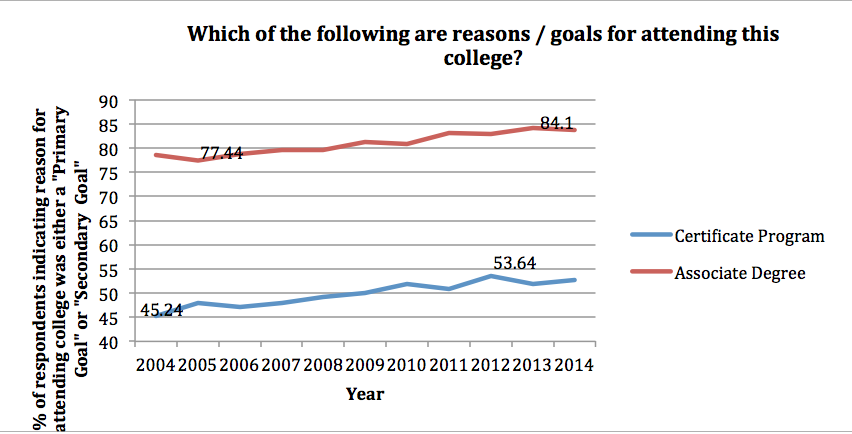Improve Advising to Help Students Reach Completion
By Evelyn N. Waiwaiole
July 15, 2015
Colleges need to support their students to increase the number of degrees. Here are the questions colleges need to explore.
“By 2020, America will once again have the highest proportion of college graduates in the world, and community colleges will produce an additional 5 million graduates.”—President Barack Obama, Building American Skills Through Community Colleges, March 2010
Since President Obama outlined the challenge above, community colleges across the country, as well as the American Association of Community Colleges and other national higher-education organizations, have been working tirelessly to ensure not only that the front doors of our colleges are open, but also that students are walking out the back door with an associate degree or certificate in hand.
To add to the completion conversation, the chart below looks at Community College Survey of Student Engagement (CCSSE) data over time* and shows the percentage of students who marked “certificate program” or “associate degree” as their primary reason for attending college. As you can see, from 2004–2014, both of those indicators have gradually risen. This means that over the past 10 years, we have seen more and more students coming to college with the goal of obtaining a certificate or an associate degree. This is encouraging news!

Encouraging, yes. But when it comes to improving completion rates, student aspirations in isolation aren’t enough. Strong support from colleges is essential to ensure that students meet their goals. In a separate question in the CCSSE report, 92 percent of students indicated that academic advising and planning is important to them. Yet 32 percent said they rarely or never use academic advising and planning services. In a recent focus group, a student also noted, “I don’t go to the counselor; I go talk to my friends. The counselor just gives me the wrong information.” So where is this gap coming from? If students say academic advising is important, why aren’t they using it?
As colleges fundamentally redesign students’ educational experience, there are clearly some questions we need to explore, including:
- What do we know about our students?
- Which students are seeing advisers?
- What types of students aren’t seeing advisers?
- For those who see an adviser, why are they?
- What do we know about our advisers?
- How are the advisers trained?
- Is advising consistent?
- What do we know about our policies and practices?
- Is attending an advising session mandatory?
- How often does a student have to see an adviser?
Bottom line: All of our community colleges should conduct an audit of their existing advising systems. We can’t plan how to redesign if we don’t know what is working and what needs improvement.
With all of our students, especially our first-generation, underprepared, older students and our students who just need extra support entering community college doors, it is essential that we reconsider the role of advising. As students try to navigate structured pathways or to transfer, timely and accurate information is critical. Students tell us advising is important, but if they don’t use it, we must understand why and then redesign the process to ensure that we are doing everything we can to support our students — and to reach the completion goals President Obama set forth for our colleges.
* For a complete review of CCSSE data over time, read Engagement Rising: A Decade of CCSSE Data Shows Improvement Across the Board.










